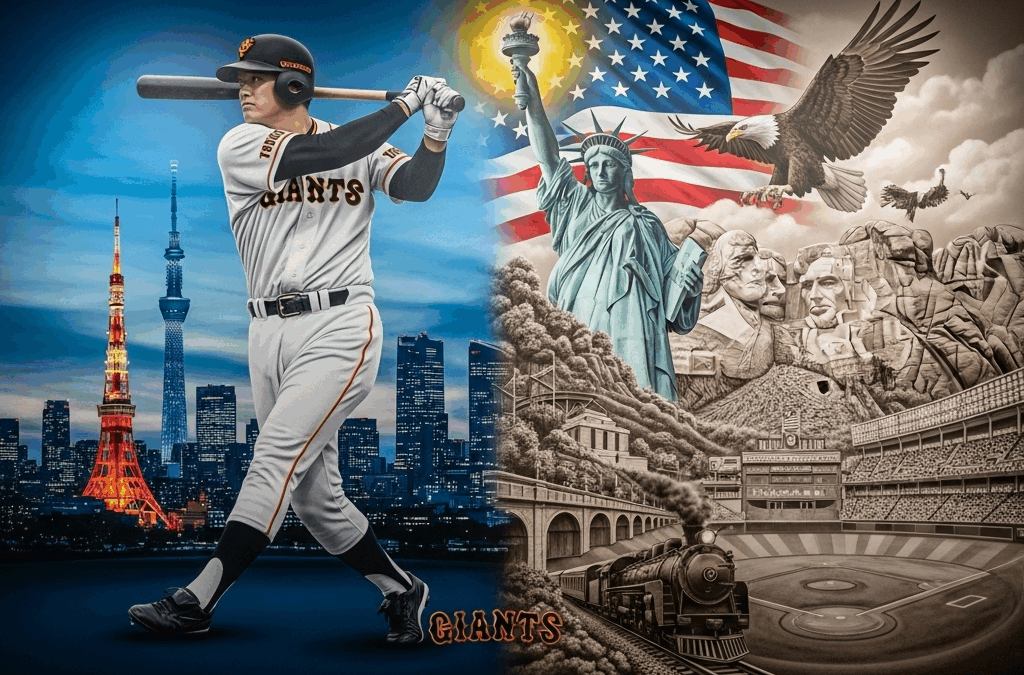Why MLB fans should add a Giants game to their next Japan itinerary
In Japan, the Yomiuri Giants are often dubbed “Japan’s New York Yankees.” The parallels are striking: they own the most championships in the league, dominate nationwide media through the Yomiuri newspaper and Nippon TV network, and inspire an intense love-them-or-hate-them passion that mirrors the Bronx Bombers’ aura. But the moniker runs deeper than success. From Babe Ruth’s 1934 barn-storming tour to Major League Baseball’s 2025 Opening Series in Tokyo, the Giants’ story has been woven together with American baseball for more than ninety years.
- 1. 1934 – A Team Born from Babe Ruth’s Tour
- 2. 1935 – 1950s – Friendship Through War and Reconstruction
- 3. 1959 – The Emperor’s Game & Mr. Nagashima’s Walk-Off
- 4. 1960s – Spring Training in Dodgertown
- 5. 1970s – 1980s – Cromartie, MLB All-Stars & Global Branding
- 6. 1990s – 2000s – Hideki Matsui and a Yankees Reunion
- 7. 2010 – 2025 – Center Stage of the Global Game
- 8. Five Reasons the Giants Are “Japan’s Yankees”
- 9. Tokyo Dome Game-Day Guide for MLB Fans
- 10. Conclusion – One Baseball, Two Nations, Shared History
1. 1934 – A Team Born from Babe Ruth’s Tour
When Babe Ruth, Lou Gehrig, and a cast of MLB All-Stars electrified Japan in the fall of 1934, media mogul Matsutarō Shōriki sensed an opportunity. To preserve the fever Ruth sparked, he founded the Great Japan Tokyo Baseball Club—the forerunner of today’s Yomiuri Giants. In effect, American baseball culture mid-wifed Japan’s first professional franchise, planting the seed for a rivalry-turned-kinship that would span the Pacific.
2. 1935 – 1950s – Friendship Through War and Reconstruction
The very next year the new club embarked on a 126-game U.S. tour, an unprecedented undertaking for the pre-war era. Players faced barn-storming Negro League teams, Minor Leaguers, even occasional big-league lineups on dusty western diamonds. After World War II, U.S. occupation forces helped revive Japanese baseball, and the 1950s saw visits from the New York Giants, Yankees, and Dodgers. Annual U.S.–Japan goodwill games soon became a fixture, knitting the two baseball worlds together at a moment when cultural bridges were urgently needed.
3. 1959 – The Emperor’s Game & Mr. Nagashima’s Walk-Off
On June 25 1959, Emperor Shōwa and Empress Kōjun attended Japan’s first-ever pro ball game watched by a reigning monarch. It was instantly labeled the Tenran Jiai—“the Emperor’s Game.” Tied in the bottom of the ninth at old Korakuen Stadium, Shigeo “Mr. Giants” Nagashima launched Tigers ace Minoru Murayama’s fastball into the left-field bleachers for a dramatic walk-off. The swing didn’t merely win a game; it catapulted Nagashima into nationwide superstardom and cemented professional baseball as Japan’s true national pastime.
4. 1960s – Spring Training in Dodgertown
Invited by Dodgers owner Walter O’Malley, the Giants held spring camp at Vero Beach’s storied Dodgertown in 1960 and 1961. Slugging duo Sadaharu Oh and Shigeo Nagashima soaked up big-league conditioning drills, data-driven scouting reports, and everyday professionalism. The lessons took root: Tokyo captured nine straight Japan Series titles from 1965 through 1973, a dynasty built on the Dodgers’ blueprint and powered by the legendary “O-N Cannon.”
5. 1970s – 1980s – Cromartie, MLB All-Stars & Global Branding
American imports reshaped the roster beginning in the late ’70s, none more popular than Warren Cromartie. The former Expo’s swagger turned Tokyo Dome’s right-field stands into a mini-Bronx, earning the nickname “Tokyo Bronx.” Meanwhile, MLB All-Star tours in 1974, 1978, and 1984 drew packed houses as Reggie Jackson, Pete Rose, and Mike Schmidt squared off against Giant greats. Each series amplified the Giants’ reputation as baseball’s international brand before “globalization” was a buzzword.
6. 1990s – 2000s – Hideki Matsui and a Yankees Reunion
At the dawn of the 21st century, cleanup hitter Hideki Matsui—nicknamed “Godzilla”—crossed the Pacific to join the New York Yankees. In 2009 he became World Series MVP, the first Japanese-born position player so honored. Kōji Uehara and Hisanori Takahashi followed his path, symbolizing a player pipeline that now flows both ways. A 2004 Yankees-Giants exhibition in Tokyo sold out within minutes, proving that New York and Tokyo could share fans—and revenue streams—across twelve time zones.
7. 2010 – 2025 – Center Stage of the Global Game
Tokyo Dome has matured into a routine stop on MLB’s World Tour. The 2025 Dodgers–Cubs Opening Series sold out instantly, while streaming numbers in the United States shattered previous records for games played on Asian soil. Former Yankee Rougned Odor slipped on the Giants’ orange “YG” cap in 2024, blurring the lines between leagues. When icon Shigeo Nagashima passed away on June 3 2025, MLB ballparks held moments of silence, poignant proof of the two nations’ intertwined baseball soul.
8. Five Reasons the Giants Are “Japan’s Yankees”
- Most Championships: 36 Central League pennants and 22 Japan Series titles—both all-time records.
- Nationwide Media Reach: Backed by the Yomiuri media empire, every game airs coast-to-coast in Japan.
- Star Magnet: From Nagashima and Oh to Matsui and Odor, marquee talent gravitates to Tokyo.
- Big-Market Spending: Free-agent splurges echo the Yankees’ Bronx Bombardiers approach.
- Love-Them-or-Hate-Them: Fandom is binary—devotee or detractor, seldom indifferent.
9. Tokyo Dome Game-Day Guide for MLB Fans
| What to Know | Details & Tips |
|---|---|
| Best Seats | Backstop SS: comparable to Yankee Stadium’s Legends Suite, complete with padded chairs and table service. Visitor Outfield: where drum-beating superfans create a bleacher-style frenzy—perfect for bucket-list atmosphere. |
| Tickets | Sales open 60 days out on the Giants’ English-language site; overseas credit cards welcome. If sold out, use “Seven Ticket” kiosks in any 7-Eleven—enter your passport number and print instantly. |
| Ballpark Eats | The signature “Giants Dog” pairs smoked sausage with a yuzu-pepper mayo kick. Backpack-keg beer vendors roam every aisle—yes, that’s a keg strapped to their back. |
| After-Game Hop | Walk straight to TGI Fridays inside Tokyo Dome City. Burgers, ribs, and craft beer flow late into the night while Giants highlights loop on jumbo screens—even after extra-inning marathons. |
10. Conclusion – One Baseball, Two Nations, Shared History
From Babe Ruth’s 1934 swing through Tokyo to MLB’s 2025 return, the Yomiuri Giants have stood at baseball’s Pacific crossroads. The Emperor’s Game walk-off, Dodgertown boot camps, Matsui’s Bronx heroics—each chapter reinforces their “Tokyo Yankees” identity. Next time you’re in Japan, grab an orange towel and see a Giants game in person. Every pitch at the Tokyo Dome is a living lesson in nine decades of trans-Pacific baseball—and an unmissable spectacle for any MLB traveler.


